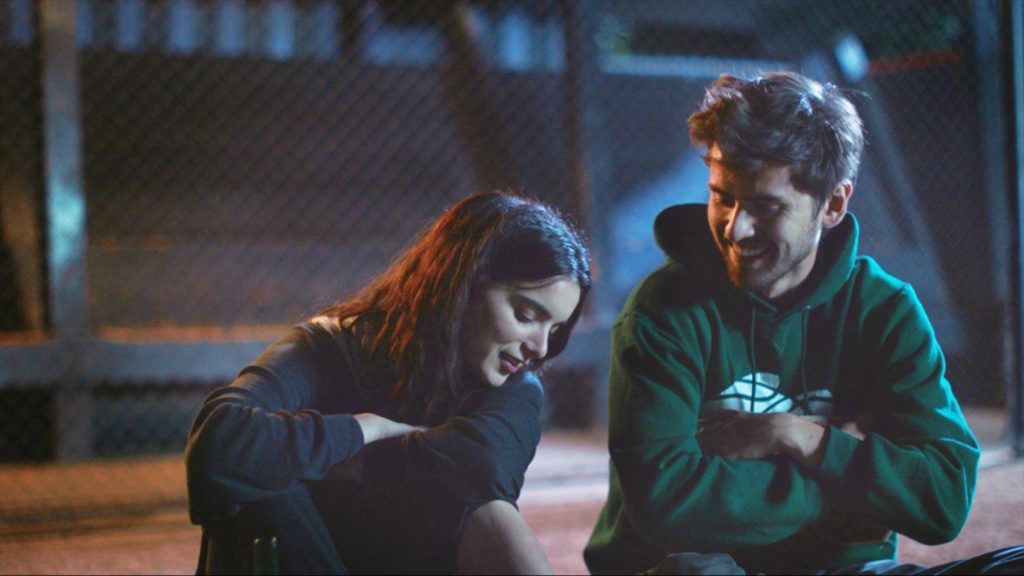July 14, 2021
by Carla Hay

“Escape Room: Tournament of Champions”
Directed by Adam Robitel
Culture Representation: Taking place in New York City, the horror film “Escape Room: Tournament of Champions” features a mostly white cast of characters (with some African Americans and Latinos) representing the middle-class.
Culture Clash: Six people are trapped by diabololical forces in an elaborate escape room, where they are forced to solve different puzzles in a limited time, or else they might die.
Culture Audience: “Escape Room: Tournament of Champions” will appeal primarily to people who saw 2019’s “Escape Room” and to people who don’t mind watching silly horror movies that have nonsensical plots.

What’s really escaped from “Escape Room: Tournament of Champions” is good filmmaking. Viewers will feel trapped in this badly made horror sequel, which consists mostly of idiotic scenes of people yelling at each other while they unrealistically solve convoluted puzzles in a very short period of time or else they could die. In real life, people who are panicking this much wouldn’t be able to have the near-psychic powers that these trapped characters seem to have when they quickly make over-the-top, elaborate deductions. The so-called “problem solving” in the movie doesn’t feel earned, because it looks exactly like what it is: overly staged nonsense from a poorly written screenplay.
“Escape Room: Tournament of Champions” is the sequel to 2019’s “Escape Room,” both directed by Adam Robitel. “Escape Room” had two screenwriters (Bragi Schut and Maria Melnik), while “Escape Room: Tournament of Champions” has four: Melnik, Will Honley, Daniel Tuch and Oren Uziel. It could be a case of “too many cooks in the kitchen.” Just like most movie sequels, “Escape Room: Tournament of Champions” is inferior to the original.
In “Escape Room,” six strangers were unwittingly chosen by a mysterious and sinister group called Minos to be in a life-or-death escape room. If you don’t know what happened at the end of “Escape Room,” you’ll be forced to know this spoiler information when watching “Escape Room: Tournament of Champions.” Two people who survived at the end of “Escape Room” are physics student Zoey Davis (played by Taylor Russell) and grocery store stocker Ben Miller (played by Logan Miller), who became friends after their traumatic ordeal.
“Escape Room: Tournament of Champions” begins with Zoey and Ben, who have traveled by plane to New York City, trying to find the unlisted building in Manhattan that Zoey thinks could be the headquarters of Minos. It’s a clue that she found at the very end of “Escape Room.” “Escape Room: Tournament of Champions” wastes time in the beginning with a terror scene of Ben being trapped somewhere, but it turns out to be a nightmare. This “it was only a nightmare” trick is used in a lot of horror movies as a way to fill up the time when the writers can’t think of anything else to further the plot.
It isn’t long before Zoey and Ben arrrive at the abandoned building that they’re sure can give them answers to who’s behind the escape room that they endured. Inside the building is a scruffy-looking guy (played by Matt Esof), who appears to be a homeless junkie. He claims to know nothing about the escape room. But he’s observant enough to see the pocket watch that Zoey has, so he lightly cuts her with a knife and steals the watch.
Zoey and Ben chase after this thief, but he’s able to escape. Out of breath and feeling defeated, Zoey and Ben go on a subway train to figure out what to do next. And this is the part of the movie where you know the “escape room” antics will start and that the other people in the same subway car will be trapped in the game too.
Sure enough, the subway car starts rocking like it’s been hit by an earthquake. There’s no train conductor in sight. And in a dumb movie like this one, the subway conveniently doesn’t have emergency brakes or a way to call for emergency services. The subway car detaches from the rest of the train, as it hurtles off the train tracks.
The six people trapped in this subway car are:
- Zoey, the smartest one in the group who’s the most likely to figure out solutions to the puzzles.
- Ben, a somewhat passive follower who keeps reminding everyone that Zoey saved his life.
- Theo (played by Carlito Olivero), the loudest and most panic-stricken person in the group.
- Rachel Ellis (played by Holland Roden), who’s very sarcastic and the one most likely to tell the terrible jokes that fall flat in the movie.
- Brianna Collier (played by Indya Moore), the one most likely to run into a booby trap so that she can predictably scream and wail.
- Nathan (played by Thomas Cocquerel), an alcoholic who seems to have given up on life until he has to fight for his life in this new escape room scenario.
Theo is an athletic-looking guy who tries to pound and kick his way out of the subway car, to no avail. He’s upset because he tells everyone that today is his wife’s birthday, and there’s no way he’s going to miss celebrating her birthday with her. It doesn’t take long for these six people trapped in the subway car to figure out that they were brought together for a reason: They all survived previous escape rooms that were masterminded by Minos. And if the reason for this gathering of survivors isn’t clear enough to viewers (because the filmmakers must think everyone watching is as dumb as this movie), Rachel announces that this must be the “tournament of champions.”
Suddenly, it looks like an electrical storm has appeared in the subway car. It’s a race against time to figure out the puzzle or else they’ll die. Underneath a seat, a purse is found with a pedal that the trapped people use for purposes that won’t be revealed in this review. The subway car’s overhead electronic announcement sign gives ominous messages with clues on how to solve the life-or-death puzzle in a very limited of time.
These clues are extremely and unnecessarily complicated to stretch out each scene into a tangled web of people shouting out theories that they think will solve the puzzle. They see an announcement that says “Beware of False Advertising.” Zoey immediately figures out that means they should look for misspelling on the ads in the subway car. Somehow, these missing letters are linked to obsolete subway tokens that mysteriously show up and have to correspond with the number of passenger handles located on the upper rails in the subway car.
Zoey has quickly figured out that there are 26 of these passenger handles in the subway car, so of course they correspond with the 26 letters of the English alphabet. One of the passenger handles has a green stripe and another handle at the opposite end of the car has a red stripe. In lightning-quick speed, Zoey deduces that the green-striped handle stands for the letter “a,” and the red-striped handle stands for the letter “z.”
And so, when certain misspelled or missing letters are found on the subway ads, there’s a mad dash to find the passenger handles that correspond with that letter of the alphabet. When these handles are pulled, they reveal tokens that have to be put in a token slot box before time runs out. They’re supposed to do all of this in about 10 minutes, which is a ridiculously short amount of time for even the most logical, genius-level person to figure out while tapped in a subway car filled with electrical lightning that could kill anyone at any moment.
Conveniently, the subway car has a trap door that opens if they figure out the puzzle in time. And you know that this puzzle will be solved, because if it wasn’t solved, “Escape Room: Tournament of Champions” would be a very short movie. Other puzzle scenarios in “Escape Room: Tournament of Champions” include figuring out elaborate codes in a deserted bank with deadly security lasers; trying not to get trapped in quicksand on an idyllic-looking beach; and figuring out how to get protection when stuck out on a street where it’s literally pouring acidic rain.
“Escape Room: Tournament of Champions” has a semi-obsession with burning or electrocuting the people who are trapped in this moronic game. And the movie has moments that are unintentionally funny because they’re so badly written. None of the acting in this movie is outstanding. It’s all very formulaic.
And forget about getting to know the characters in the movie, because they’re as hollow as hollow can be. Except for Zoey and Ben, none of the characters has a significant backstory. People who saw the first “Escape Room” movie will learn nothing new about Zoey and Ben in this sequel.
It’s mentioned that Brianna is a travel vlogger, but she’s such a stereotypical screaming ninny in a horror movie that she couldn’t find her way out of a paper bag. Theo is a lunkhead who foolishly thinks he can strong-arm his way out of the escape room. Nathan has a vaguely mentioned troubled past that he’d like to forget, while Rachel is just forgettable.
Instead of having actual personalities, the characters in “Escape Room” are just lines of horribly written dialogue and just spend a lot of time shouting at each other about what they think they should do next. Because they don’t always agree, the bickering wastes even more time. And there’s always one second left in the countdown when anyone survives in time to go on to the next puzzle. It all becomes so tedious and predictable after a while.
Perhaps the most awful part of “Escape Room: Tournament of Champions” is that it tells viewers that any death that happens in this movie series might not be a real death. One of the people who “died” in the first “Escape Room” movie suddenly shows up to help in “Escape Room: Tournament of Champions.” Because this is such a terrible movie, there’s no logical reason given for why or how this person survived, even though the death was clearly shown in the first “Escape Room” movie.
Zoey and Ben are shocked to see this person, who has this vapid explanation when Zoey and Ben ask why this person isn’t dead: “If you didn’t see it, it didn’t happen.” In other words, more mindless excuses to have plot holes. And that means more ridiculousness if the “Escape Room” movie series continues. The dimwitted end of “Escape Room: Tournament of Champions” makes it clear that the filmmakers want to dump more “Escape Room” movies into the world. That’s a trap that fans of good horror movies can avoid.
Columbia Pictures will release “Escape Room: Tournament of Champions” in U.S. cinemas on July 16, 2021.


